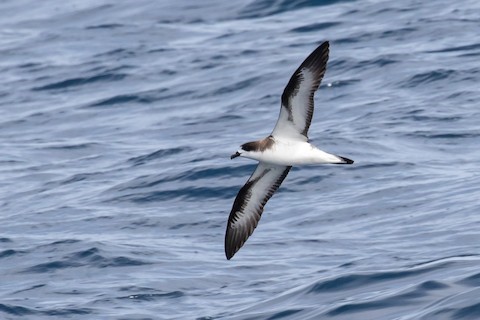Birdfinding.info ⇒ The most accessible site for Hawaiian Petrel is the rim of Haleakala Crater in Haleakala National Park, where breeding birds can be heard at night (and sometimes seen arriving around dusk) from early March to mid-August. It would be among the expected species on any pelagic trip in the main Hawaiian Islands throughout the breeding season, from March to October, and there are a few prominent seawatches where it can sometimes be seen, including Hanapepe and Makahuena Point in Poipu, both on Kauai, and Keāhole Point on the Big Island. Since the 1990s it has been found year-round in tiny numbers on offshore trips from Oregon and northern California, and less regularly north to British Columbia and south to southern California.
Hawaiian Petrel
Pterodroma sandwichensis
Breeds in the main Hawaiian Islands, and ranges across the eastern North Pacific Ocean.
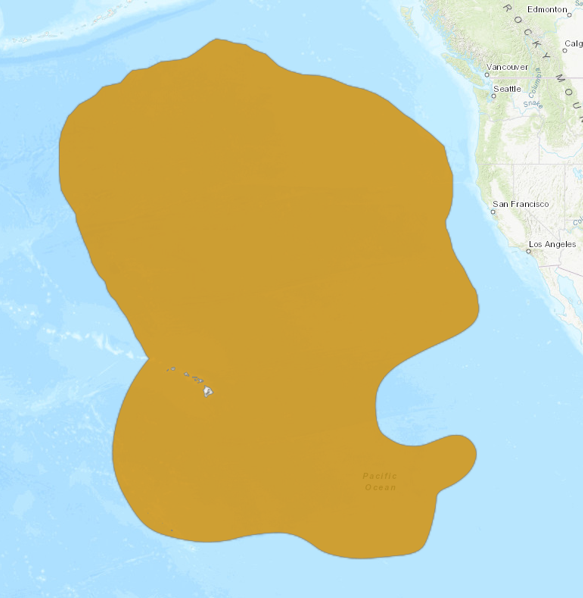
Approximate range of the Hawaiian Petrel. © BirdLife International 2018
Breeding. Breeds from February or March to October (most eggs laid in May or June) on Kauai, Lanai, Maui, and the Big Island. Most nesting areas are in mountains, but the habitat varies from bare lava fields to cloud forest.
Kauai’s population has been estimated at around 1,600 pairs, concentrated in Upper Limahuli Preserve, Hono a Napali, and Kahili-Kapalaoa.
Lanai’s population has been estimated in the range of 2,000 to 3,000 pairs, mainly in the cloud forest at Lana’i’hale.
On Maui, about 1,500 pairs are thought to breed along the western rim of Haleakala Crater, and about 100 pairs in the West Maui mountains.
The Big Island population has been estimated at about 300 pairs distributed widely: in lava beds between Mauna Kea and Mauna Loa; on the southeastern slopes of Mauna Loa; near Kilauea Crater; on Hualalai; and in the northern Kohala Mountains.
Formerly bred in the mountains of eastern Molokai, and some isolated detections of petrels flying inland at night indicate that it may still breed there. Subfossil remains indicate prehistorical breeding on Oahu.
Nonbreeding. The Hawaiian Petrel’s range at sea encompasses much of the North Pacific north and east of Hawaii. There are records at all times of year in offshore waters from the Queen Charlotte Islands south to Baja California.
During the breeding season, it is often found at sea near the main Hawaiian Islands, including southward (by approximately 100-200 miles, based on reports from vessels in transit to or from Kiribati). Research using satellite telemetry indicates that some breeding birds regularly commute north to the Aleutian Islands.
There are few field observations west of the main Hawaiian Islands, but satellite telemetry studies indicate that it wanders across the western Pacific at least as far as the Mariana Islands and presumably farther.
Identification
A medium-large gadfly petrel with a fairly simple pattern: nearly all-dark upperparts and nearly all-white underparts, with black-and-white underwings. Essentially identical to Galápagos Petrel (see below).
The head pattern is strong and contrasty: white forehead and throat versus black cap and dark-gray cowl.
The underwings are mixed black-and-white: broadly tipped black with a black trailing edge, thick black leading edge, and thin black carpal bar.
When the tail is folded, it appears long, thin, and tapered to a point. Seen from below, the undertail coverts are all-white, and the dark tail is usually visible only as a narrow tip or band.

Hawaiian Petrel, showing typical cowl and underwing pattern. (Offshore from Monterrey, California; August 2, 2013.) © Brian Sullivan
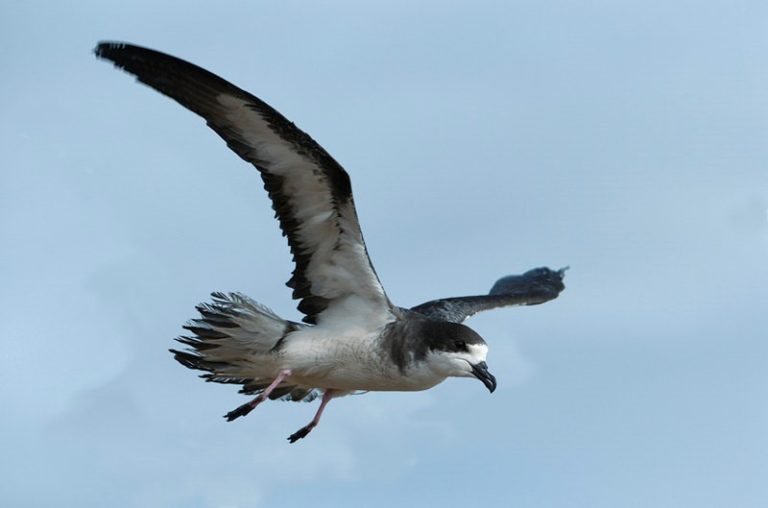
Hawaiian Petrel, with tail fanned. (Eleele, Kauai, Hawaii; November 26, 2005.) © Jim Denny
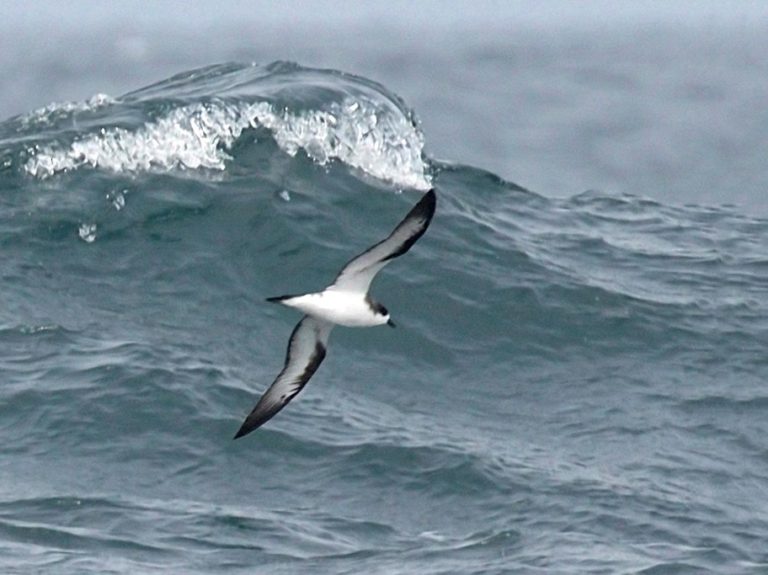
Hawaiian Petrel. (Offshore from Monterrey, California; August 25, 2017.) © Beth Hamel
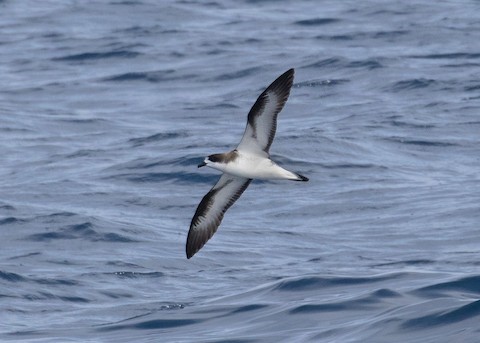
Hawaiian Petrel, showing typical cowl and underwing pattern. (Offshore from Newport, Oregon; August 24, 2019.) © Doug Backlund

Hawaiian Petrel. (Offshore from Monterrey, California; August 25, 2017.) © James Holmes
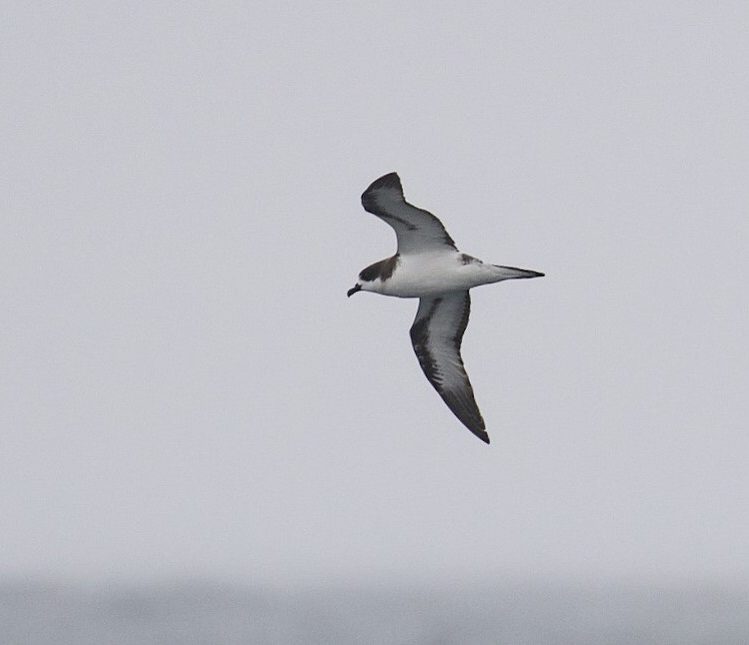
Hawaiian Petrel. (Offshore from Newport, Oregon; August 27, 2016.) © Ken Chamberlain
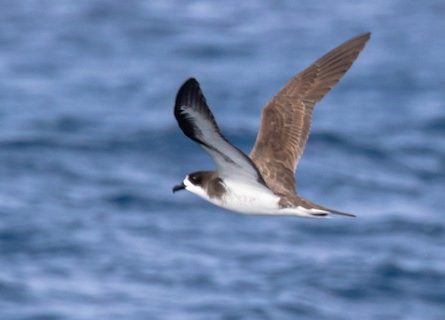
Hawaiian Petrel. (Offshore from Newport, Oregon; August 24, 2019.) © Ken Chamberlain
The upperparts often appear uniformly dark-gray, including the rump. Depending on feather-wear and lighting, some differences in tone may be detectable: generally somewhat paler on the back, and sometimes a faint dark M (or V).
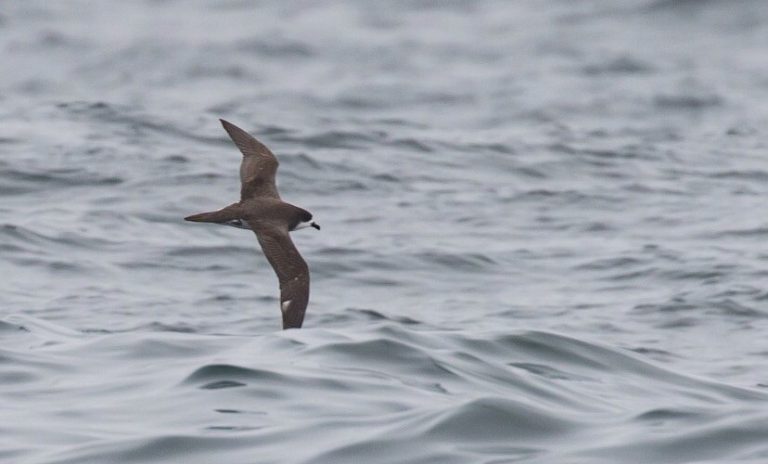
Hawaiian Petrel, showing dark-gray upperparts with subtly darker M or V. (Offshore from Newport, Oregon; August 27, 2016.) © Ken Chamberlain
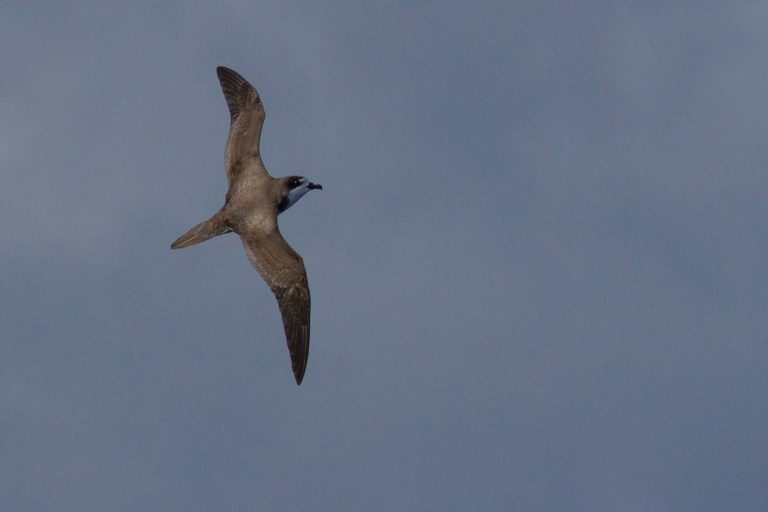
Hawaiian Petrel, showing dark-gray upperparts with paler back and adjacent wing area. (Kaulakahi Channel, Kauai, Hawaii; June 12, 2016.) © Jacob Drucker
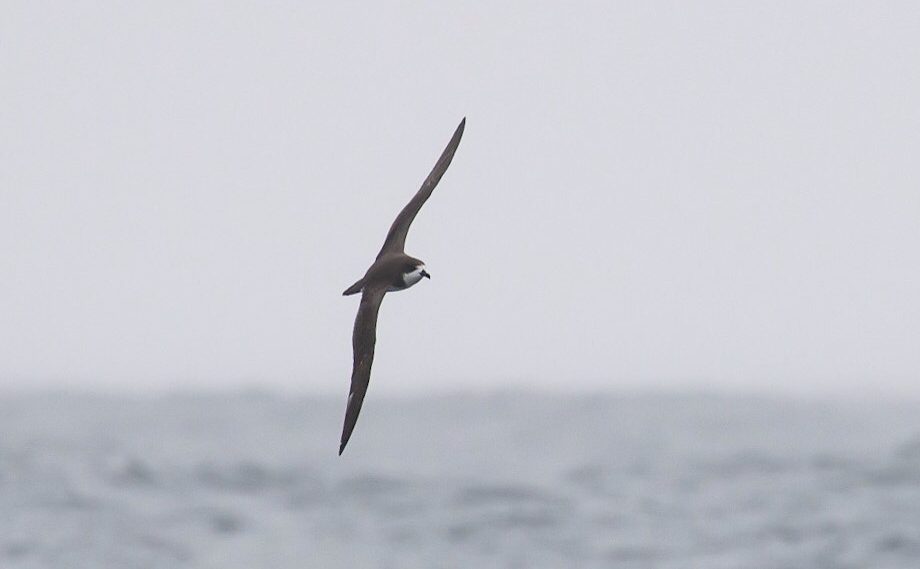
Hawaiian Petrel, showing dark-gray upperparts and crisply defined white forehead. (Offshore from Newport, Oregon; August 27, 2016.) © Ken Chamberlain
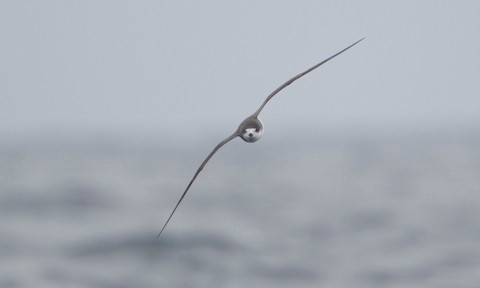
Hawaiian Petrel, frontal view. (Offshore from Monterrey, California; August 2, 2013.) © Brian Sullivan

Hawaiian Petrel, showing mostly uniform dark-gray upperwing—also note crisp facial pattern and smudgy dark cowl. (Offshore from Newport, Oregon; August 24, 2019.) © Joshua Little

Hawaiian Petrel, showing mostly uniform dark-gray upperparts. (Offshore from Newport, Oregon; August 24, 2019.) © Joshua Little
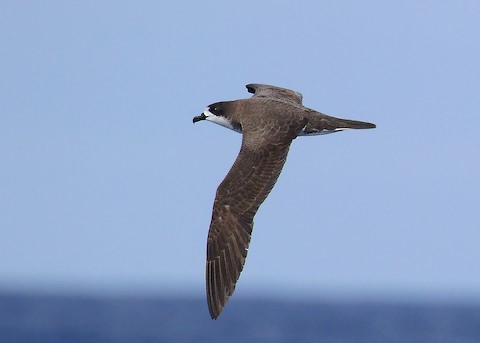
Hawaiian Petrel, showing dark-gray upperparts with paler back and adjacent wing area. (Offshore from Newport, Oregon; August 24, 2019.) © Doug Backlund
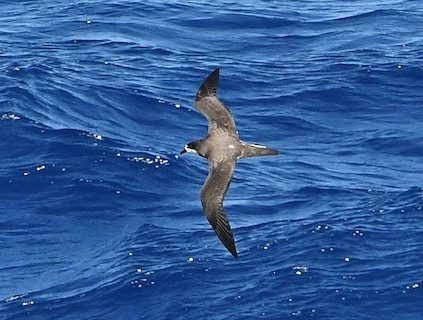
Hawaiian Petrel, showing dark-gray upperparts with paler back and adjacent wing area. (Offshore from the Na Pali Coast, Kauai, Hawaii; August 19, 2019.) © Lewis Gray
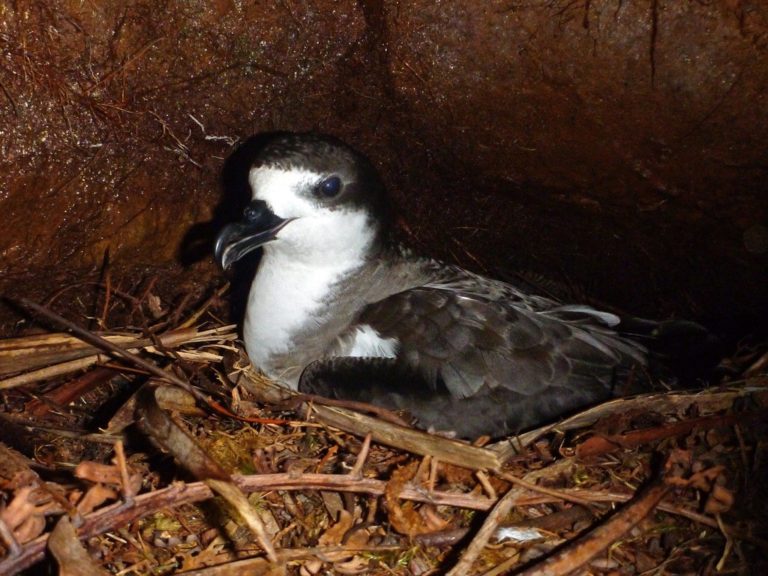
Hawaiian Petrel in nest burrow. (Kauai, Hawaii; July 27, 2012.) © Oscar Johnson
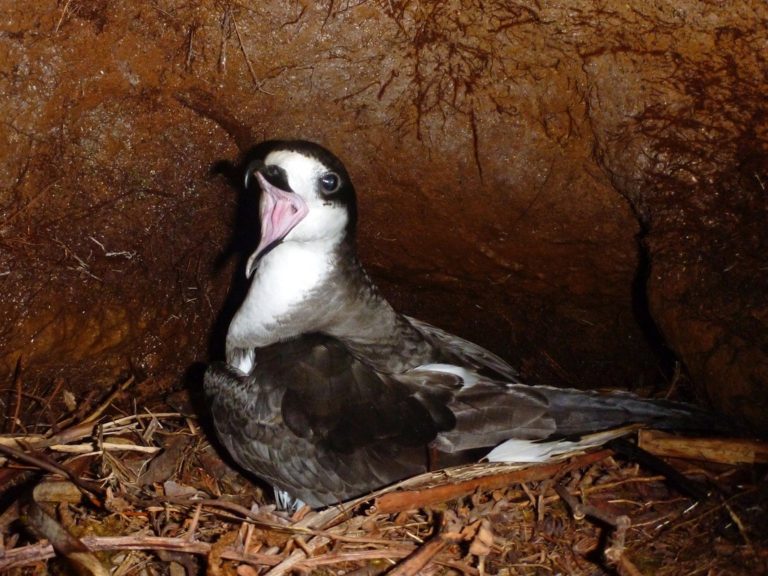
Hawaiian Petrel in nest burrow. (Kauai, Hawaii; July 27, 2012.) © Oscar Johnson
Cf. Galápagos Petrel. Hawaiian and Galápagos Petrels were long considered a single species, the Dark-umped Petrel. They are nearly identical, and would rarely be distinguishable at sea under typical field conditions. Their ranges are not known to overlap, so they can usually be identified by probability according to the location, but there are some locations where both are equally probable, and it is always possible for either species to stray into the other’s range. For such occasions, there are two differences that might be apparent.
Head Pattern: Hawaiian Petrel typically shows a more crisply defined white forehead and a less extensive, paler cowl than Galápagos.
Underwing Pattern: Galápagos Petrel often shows a dark smudge where the wing meets the body, which Hawaiian consistently lacks. Galápagos also tends to show a stronger carpal bar on the inner portion of the underwing and a slightly thinner black leading edge than Hawaiian—so on Hawaiian the black on the underwing is concentrated away from the body, whereas on Galápagos the black is more evenly distributed on the inner and outer portions of the underwing.
Notes
Monotypic species. Formerly considered conspecific with Galápagos Petrel, collectively known as the Dark-rumped Petrel (P. phaeopygia).
IUCN Red List Status: Endangered.
References
BirdLife International. 2018. Pterodroma sandwichensis. The IUCN Red List of Threatened Species 2018: e.T22698017A132378813. https://dx.doi.org/10.2305/IUCN.UK.2018-2.RLTS.T22698017A132378813.en. (Accessed June 3, 2020.)
eBird. 2020. eBird: An online database of bird distribution and abundance. Cornell Lab of Ornithology, Ithaca, N.Y. http://www.ebird.org. (Accessed March 19, 2020.)
Harrison, P. 1983. Seabirds: An Identification Guide. Houghton Mifflin, Boston.
Howell, S.N.G., and K. Zufelt. 2019. Oceanic Birds of the World. Princeton University Press.
Pratt, H.D. 1993. Enjoying Birds in Hawaii: A Birdfinding Guide to the Fiftieth State (Second Edition). Mutual Publishing, Honolulu, Hawaii.
Pyle, R.L., and P. Pyle. 2017. The Birds of the Hawaiian Islands: Occurrence, History, Distribution, and Status. Version 2 (January 1, 2017). http://hbs.bishopmuseum.org/birds/rlp-monograph/. B.P. Bishop Museum, Honolulu, Hawaii.

